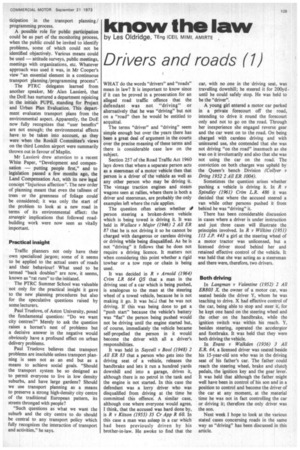know the law
Page 111

If you've noticed an error in this article please click here to report it so we can fix it.
by Les Oldridge, TEng (CEO, MIMI. AMIRTE ,
Drivers and roads (1)
WHAT do the words "drivers" and "roads" mean in law? It is important to know since if it can be proved in a prosecution for an alleged road traffic offence that the defendant was not "driving" or alternatively that he was "driving" but not on a "road" then he would be entitled to acquittal.
The terms -driver" and "driving" seem simple enough but over the years there has been a great deal of argument in the courts over the precise meaning of these terms and there is considerable case law on the subject.
Section 257 of the Road Traffic Act 1960 lays down that where a separate person acts as a steersman of a motor vehicle then that person is a driver of the vehicle as well as any other person who may be driving it. The vintage traction engines and steam wagons seen at rallies, where there is both a driver and steersman, are probably the only examples left where the rule applies.
The question often arises whether at person steering a broken-down vehicle which is being towed is driving it. It was held in Wallace v Major (1946) 2 All ER 87 that he is not driving it so he cannot be charged with dangerous or careless driving or driving while being disqualified. As he is not "driving" it follows that he does not require a driving licence. It matters not when considering this point whether a rigid towbar or a tow rope or chain is being used.
It was decided in R v Arnold (1964) Crim LR 664 QS that a man in the driving seat of a car which is being pushed. is analogous to the man at the steering wheel of a towed vehicle, because he is not making it go. It was he.i that he was not driving. If this was being done to get a "push start" because the vehicle's battery was "flat" the person being pushed would not be driving until the engine started but, of course, immediately the vehicle became self-propelled the person in it would become the driver with all a driver's responsibilities.
It was held in Sa_vcell v Bool (1948) 1 All ER 83 that a person who gets into the driving seat of a vehicle, releases the handbrake and lets it run a hundred yards downhill and into a garage, drives it, although there is no petrol in the tank and the engine is not started. In this case the defendant was a lorry driver who was disqualified from driving at the time he committed this offence. A similar case, although one where everyone would agree, I think, that the accused was hard done by, is R v Kitson (1955) 35 Cr App R 60. In this case a man was asleep in a car which had been previously driven by his brother-in-law. He awoke to find that the
car, with no one in the "driving seat, was travelling downhill; he steered it for 200yd • until he could safely stop. He was held to be the "driver".
A young girl entered a motor car parked in a private forecourt off the road, intending to drive it round the forecourt only and not to go on the road. Through her inexperience she engaged reverse gear and the car went on to the road. On being charged with careless driving and with uninsured use, she contended that she was not driving "on the road" inasmuch as she was on it involuntarily and also that she was not using the car on the road. The conviction on both charges was upheld by the Queen's bench Division (Collyer v Dring 1952 2 All ER 1004).
Sometimes the question arises whether pushing a vehicle is driving it. In R v Spindley (1%1) Crim L.R. 486 it was decided that where the accused steered a van while other persons pushed it from behind he was "driving" it.
There has been considerable discussion in cases where a driver is under instruction and just three cases will illustrate the principles involved. In R v Wilkins (1951) 115 J.P. 443 a girl at the steering wheel of a motor tractor was unlicensed, but a licensed driver stood behind her and retained effective control of the vehicle. It was held that she was acting as a steersman and there were, therefore, two drivers.
Both driving
In Langman v Valentine (1952) 2 All ER803 X, the owner of a motor car, was seated beside the driver Y, whom he was teaching to drive. X had effective control of the car, being able to stop and steer it, for he kept one hand on the steering wheel and the other on the handbrake, while the ignition switch was within his reach. Y. besides steering, operated the accelerator and footbralce. It was held that they were both driving the vehicle.
In Evans v Walkden (1956) 3 All E.R. 64, a licensed driver was seated beside his 15-year-old son who was in the driving seat of his father's car. The father could reach the steering wheel, brake and clutch pedals, the ignition key and the gear lever. It was held that although the father might well have been in control of his son and in a position to control and become the driver of the car at any moment, at the material time he was not in fact controlling the car or driving it; therefore the only driver was the son.
Next week I hope to look at the various stated cases concerning roads in the same way as "driving" has been discussed in this article.
















































































































































































